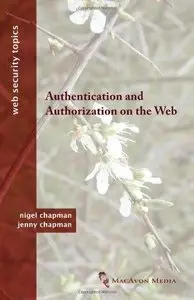Authentication and Authorization on the Web By Nigel Chapman and Jenny Chapman
2012 | 246 Pages | ISBN: 0956737056 | EPUB + MOBI | 2 MB
2012 | 246 Pages | ISBN: 0956737056 | EPUB + MOBI | 2 MB
A short book in the "Web Security Topics" series for Web developers, by the well-known authors Nigel and Jenny Chapman. Web applications manipulate resources in response to requests from users. It is often necessary to determine whether a requested operation should be allowed for the user who sent the request. This process of authorization - that is, deciding whether an application should be allowed to carry.out the operation which a request from a particular user or program calls for - depends on, but is separate from, the process of authentication. Authentication means determining the identity of the user or program sending the request. This is usually done by maintaining user accounts, protected by passwords, and by requiring users to log in. Written for professional and student Web developers, this book provides a clear and practical description of authentication and authorization for Web sites. Secure methods of storing users' account details are described, with special emphasis on the secure storage of passwords. The authors explain different methods of authentication, and techniques for applying authorization to requests from authenticated users. A simple application, written in JavaScript and built on the Express framework, is developed throughout the book to demonstrate the principles. The source code is provided via the companion site websecuritytopics.info. Topics covered include hashing and salting passwords for secure storage, using CAPTCHAs to prevent the creation of bogus accounts, resetting passwords, session-based authentication and attacks against sessions, HTTP authentication, OpenId, authorization based on user accounts, role-based authorization, and OAuth. Notes on relevant topics in cryptography are also included. Clear key points provide useful summaries at the end of each section, and technical terms are defined in a 16-page glossary.



